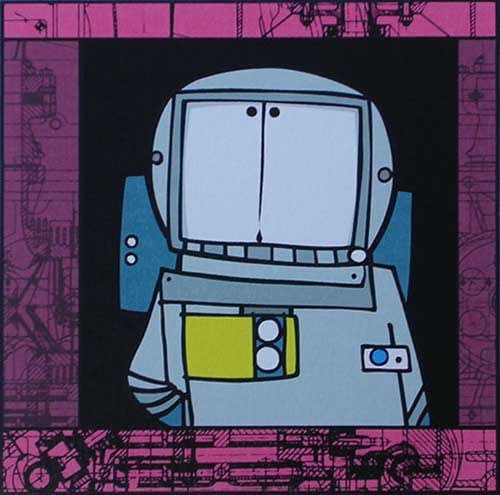"The machine does not isolate man from the great problems of nature but plunges him more deeply into them." Antoine de Saint-Exupéry
Retrotech examines the presence of technology in Ted Dutch’s oeuvre; his fascination with objects, devices and machinery evident in his highly stylised, colourful and humorous responses to the anxieties of the twentieth century.
Although Dutch’s style varied throughout his career, his aesthetic and conceptual interest in technology recurred consistently throughout. The world of Ted Dutch is often populated by broken machinery, impossible monuments, flying machines, industrial activity and busy-ness: a realm where astronauts, technicians, signalers and guards wind the cogs and grease the wheels.
The structure of these works have emerged from some of the artist’s earliest defining experiences, primarily those at the age of 12 when sketching the structural innards of bombed London during the Blitz. However, the prevalence of technology throughout Dutch’s work can only have arisen from the artist’s lifelong fascination with things that tick, whirr and buzz.
The exhibition provides a unique opportunity to gain an insight into this facet of Dutch's works; one of the most significant and distinctive aspects of his multi-layered artistic practice.
About Ted Dutch
Ted Dutch was born in London in 1928 and decided at age 8 that he was going to be an artist.. After graduating from St Martin’s School of Art in London in the mid 1940s, Ted Dutch worked as a film animator, an occupation that would later come to inform his illustrative style. In accompaniment to his commercial work, Dutch also exhibited gouache paintings as a founding member of the Graphic Arts Group. In 1951, at 23 years old, he was elected a Fellow of the Royal Society of Arts. He immigrated to New Zealand in the same year.
On arrival, Dutch found work as a graphic designer in Auckland’s screen printing industry. He became fascinated by the possibilities of screen printing as an artistic medium and from 1962 began to produce fine art screen prints. These early screen prints demonstrated Dutch’s fascination with overtly technological themes, and, like many of his later works, were overlaid with stylised schematic plans which appear to encroach on the subjects of the paintings, expressing an anxiety over the unrelenting technological progress of the period.
Dutch’s willingness to explore new artistic challenges saw his practice expand to encompass other technically-demanding media and processes. Through the seventies, he continued to work with screen printing as well as returning to painting and graphic design. During this period he also began to produce complex ceramic sculpture. These three-dimensional versions of the figures that populated his paintings and prints grew increasingly refined and achieved international recognition.
Regardless of the medium chosen, the defining feature of Dutch’s work is his quality of lines, which is simple yet immensely expressive. This is a product of his work in the animation industry, where simple, stylised line work is the key means of communicating emotion and action.
Taking cues from Picasso and Mondrian, Dutch used his playful, cartoonish style to address the prevalent anxieties of the generation. Ideas of isolation and social tension are frequently suggested, though always in a humorous, sometimes absurd manner. Dutch was keenly sensitive to the complexities of these psychological states. He evoked them effortlessly in his art, but never took himself too seriously, favouring the light over the dark.
